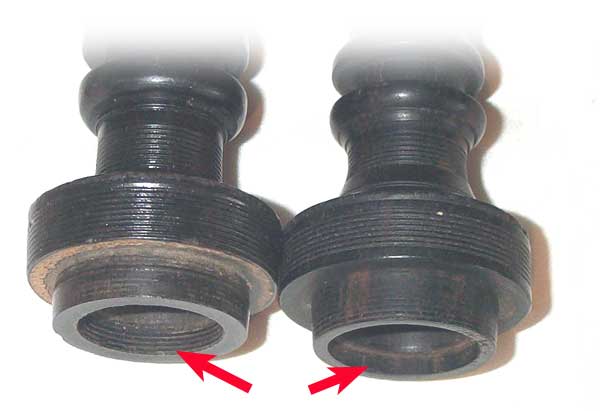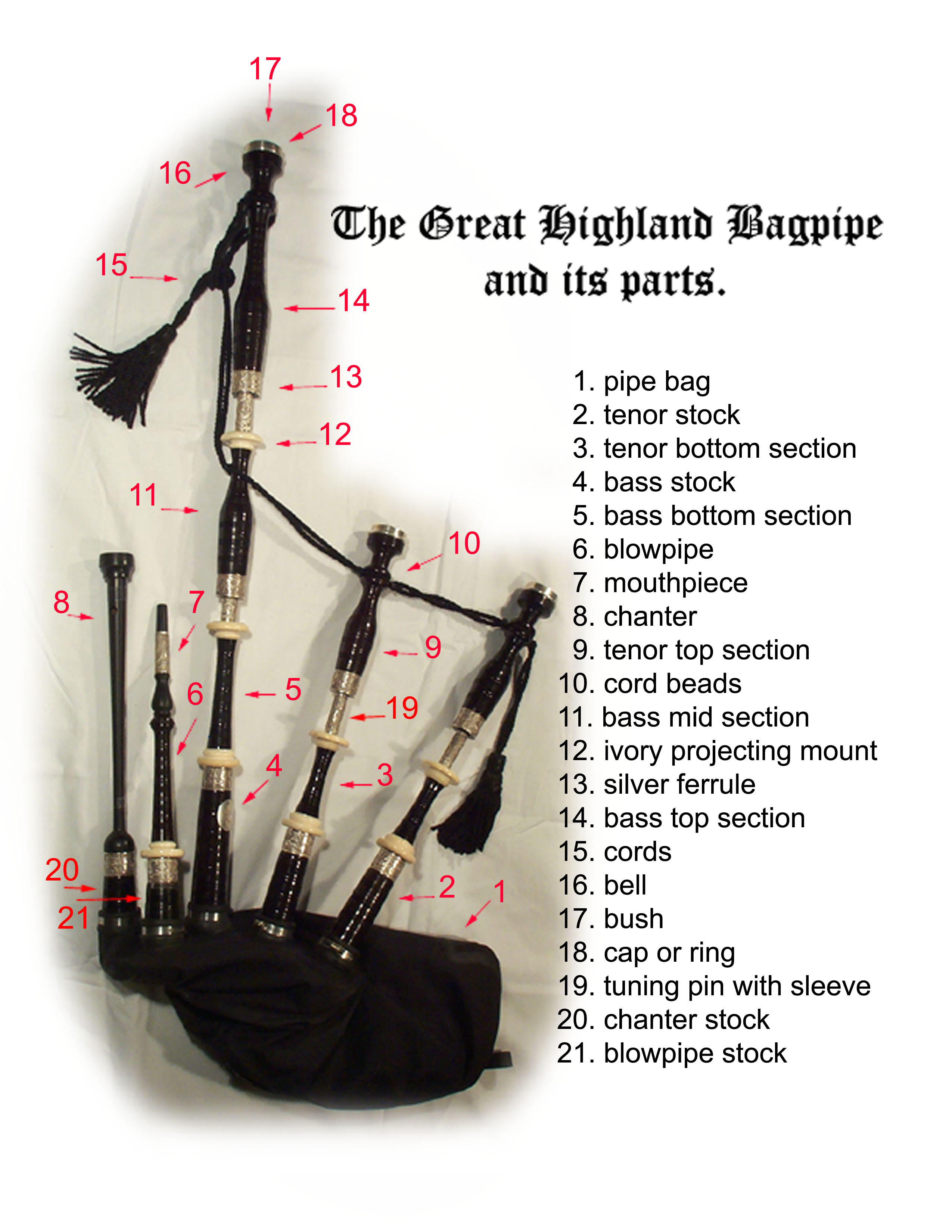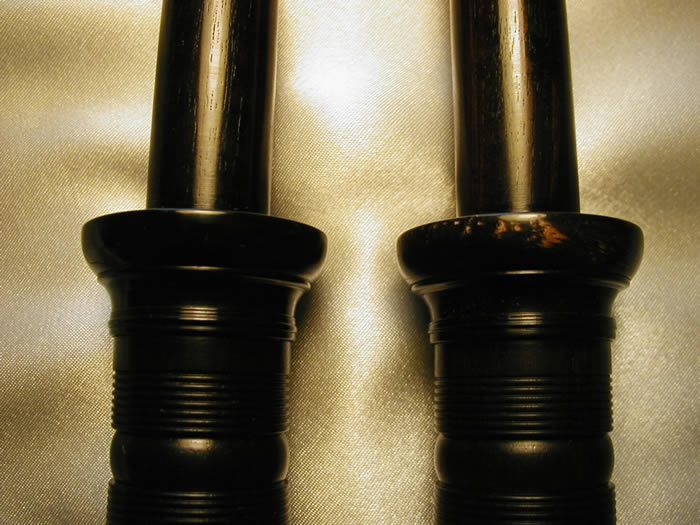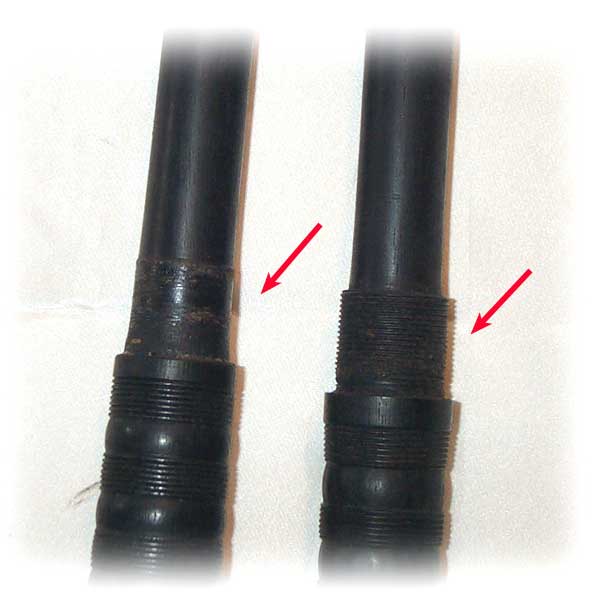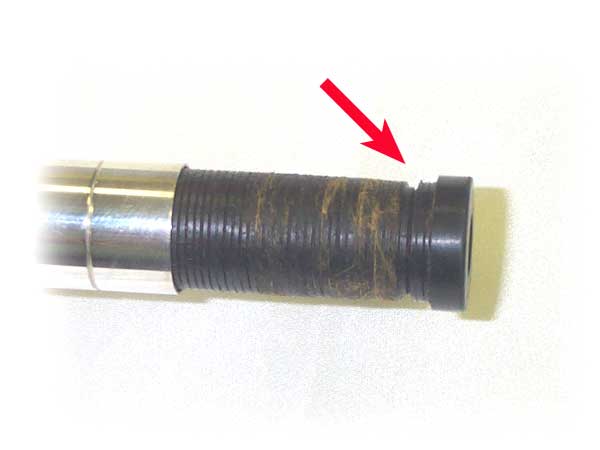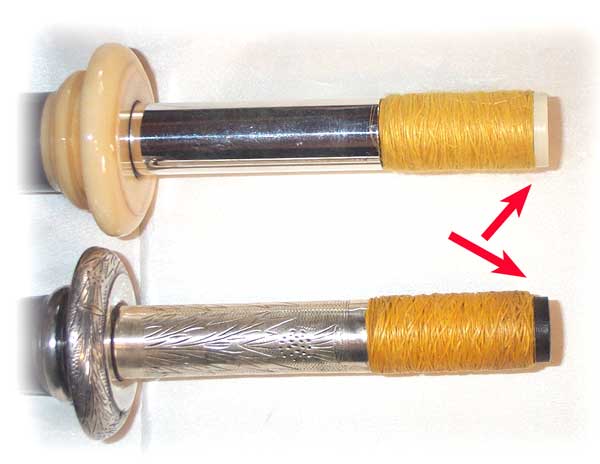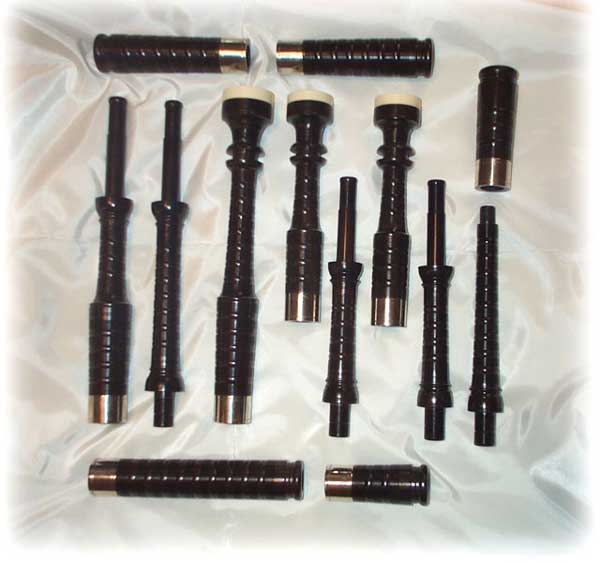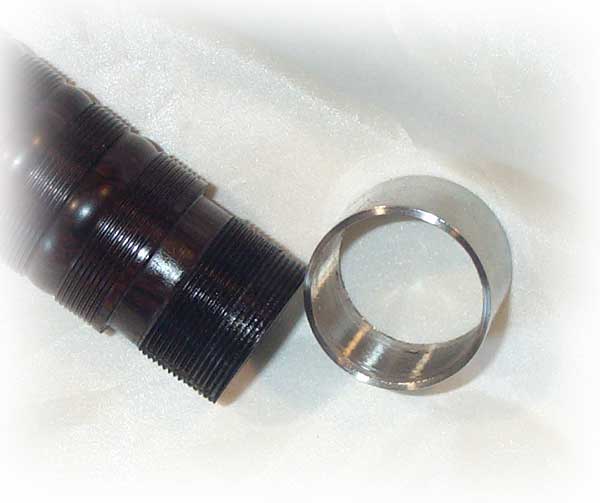What makes one bagpipe superior to another bagpipe? How do I know that I'm getting the best value for my money? Are older bagpipes better than new bagpipes? Is brand "X" better than brand "Y"? How much should I spend?
I hear these questions time and time again. I wish that the answers were simple, but in truth they are not. One thing that you'll discover is that there are many different and opposing opinions. I will leave it to you to discover why this is so. This much I will say with strong conviction. If you carefully consider the information contained herein, and use it as your benchmark, you will greatly improve the prospects of being rewarded when you make your purchase. Having a "choice" is good. Having the knowledge to make the right choice is better!
I hear these questions time and time again. I wish that the answers were simple, but in truth they are not. One thing that you'll discover is that there are many different and opposing opinions. I will leave it to you to discover why this is so. This much I will say with strong conviction. If you carefully consider the information contained herein, and use it as your benchmark, you will greatly improve the prospects of being rewarded when you make your purchase. Having a "choice" is good. Having the knowledge to make the right choice is better!
Not all bagpipes are created equally. Price is not a good indication of how well a bagpipe is made or how it will sound and/or behave.
Not all opinions are equal either. You should search hard for the reasoning behind all opinions, even those expressed herein. Sometimes by looking beyond the opinion expressed you will find clues as to why the opinion is held and passed on. Sometimes these opinions stand up to close scrutiny. Often they do not.
Are the best bagpipes made in Scotland? Not necessarily. There are very excellent bagpipes made both in Scotland and outside of Scotland. These will become evident as we work our way through this publication. There are also some terrible bagpipes made both in Scotland and elsewhere around the world. These too will become evident to you. Suffice to say, these toys should be avoided altogether. They are perhaps only suitable for wall decoration, albeit they are not even good aesthic examples of the craft they pretend to represent.
New or Used?
Many people believe that older bagpipes are best. This is not necessarily so. Older bagpipes are "older". Whether or not they are superior has nothing to do with their age. Those qualities that determine a bagpipe is "superior" hold true whether the bagpipe is one day old or one hundred years old. If you're considering purchasing a used bagpipe, the following should be taken into consideration
1. Repairs and/or replacement parts
2. Overall quality and condition
3. Cracks and warps
4. Sound and behavior
5. Reputation vs actual qualities of this particular instrument
6. Recourse
The risks associated in buying a used bagpipe are directly proportionate to your own level of knowledge. If you are a begining piper, or if your knowledge of used bagpipes is limited, the risks are great. (click here) A second opinion may or may not reduce the risks. In all instances it is best to factor all the risks into your purchase price.
In many instances new bagpipes are far less risky that used bagpipes. When you buy new, you know where the instrument came from. You also know that the instrument hasn't been abused or neglected. You also know that it's 100% original and it's usually backed by the manufacturer's guarantee. Unless you're an absolute expert in used bagpipes, new bagpipes deliver far greater value with little or no risk.
What to look for!
To the untrained eye, one set of bagpipes pretty much looks like the next set of bagpipes. The more familiar you become with bagpipes the more obvious (and critical) small details become.
The first thing that I see is the finish on the wood. I immediately reject anything that looks thick and syrupy. These finishes are not intended for quality musical instruments. They are intended to disguise poor wood and poor machining.
I prefer thin, clear finishes. This might be a wax or oil finish or it might be a shellac-based finish. These not only allow the natural beauty of the wood to shine through but they also allow the wood to breathe and move with changes in conditions. They will accept an exterior oiling and are easily renewed with a soft cloth and some loving care.
Looking beneath the finish I hope to find a grain that is close and straight. I don't want to see open pores and grains that twist and curve. I also want the wood to feel heavy. This is a bit subjective however handling a number of pipes will help you to develop a "feel" for the instrument.
I also want to see the instrument well-designed. I prefer tapers rather than square corners and sharp edges. I want to see a consistent theme throughout the bagpipe of convex or concave lines, sizes, shapes, and complimentary fittings. Everything has to look like it belongs together.
Detailing
There are three basic categories for detailing;
1) plain finished
2) beaded and combed
3) carved.
As suggested, plain finished is simply turning and finishing the bagpipe to a smooth surface throughout. Some plain finishing is enhanced with combing, referred to as flat combing (in reference to the plain smooth surface and lack of beads).
Beading and combing creates additional interest and is applied with special tools. Beading and combing is most effective when it is done uniformly with care and skill.
Carving is a completely different method of decorating a bagpipe. Done correctly it can add unique interest and beauty, albeit somewhat subject to the eye of the beholder.
All finishing should stand up to the closest scrutiny. I carry a powerful magnifying glass with me to allow for the closest possible inspection. Why? Although some makers would find fault in this, the better makers are flattered that their work is so greatly studied and appreciated.
Image of beading.jpg
This is an excellent example of what is explained above. Note the wood, finish, and detail of the beading and combing. Everything is perfect! The way it should be! Notice how the tops of the beads are in line with the top of the combing? This speaks to the quality of the turning.
Mounts and ferrules
Check all the mounts and fittings to ensure consistency. Every fitting, every ferrule, every mount should fit properly, perfectly flush with the wood. Reject any with gaps or uneven spots. If you see filler of any description between the wood and any fittings, reject the piece and the maker. Again, all imitation ivory ferules and projecting mounts of any material should be threaded and tightened into place. Beware of those makers who do not thread these fittings into place.
Metal ferrules, slides, and caps come in a variety of alloys. These include nickel, nickel-plated, bronze, copper, stainless steel, silver, sterling silver, and gold-plated metals. These fittings are not always threaded. They are more often pressure-fitted or glued onto the wood. Many glues do not adhere to some metals. Other glues break down over time. Some makers are now threading on their metal fittings. While perhaps not critical, this does speak to higher manufacturing standards.
Here is an example of what you'll find under mounts and ferrules. The example on the left is the "cheaper" way to attach fittings. There are a couple of lines cut into the wood to hold the glue and the fitting is slid into place. The glue generally breaks down and the fittings come loose.
The example on the right speaks of higher quality. The wood and the fitting are both threaded. A drop of glue is put on the threads and the fitting is screwed and locked into place. These fittings generally do not loosen.
This is another example of corners cut. The bushing atop the drone bell should be threaded and screwed into place. If not, as in the example on the right, they have a tendency to leak air and to fall out. This is yet another detail that is hard to spot but very important in the overall construction of a bagpipe.
CNC made bagpipes
Many makers now are using CNC equipment for various jobs in the manufacturing process. There are very definite "pluses" to CNC machining however it lessen or eliminate the need for skilled tradespeople. Components must be brought together and professionally finished at some point. All facing should be perfect. Reject bagpipes here ferrules extend beyond the wood leaving a sharp edge. Reject bagpipes where facing between fixtures and wood is not perfect. Study the bagpipe before buying and you won't be disappointed later.
Tuning Pins
A simple "test" of uniformity is to simply take the two tenor bottoms and place them pin to mount opposing each other. The pins should both touch the opposing mount equally. If one pin is shorter than the other, it will be easy to spot. You can also do this with the reed tenon, beneath the lower mount.
The pictures to the left focus on tuning pins. The first picture is a horrible mistake that was hemped over and sent out the door. Look at the deep groove cut into the wood just beneath the hemp stop. This is an obvious mistake that could have been fixed before leaving the shop. The owner of this bagpipe showed me this at a recent workshop and asked me if it was O.K.! What would you say?
Still focusing on tuning pins, the picture to the left shows two pins, one with a hemp-stop and the other without. Of course, the hemp wants to tumble off the pin with no hemp-stop. The bagpipe without the hemp-stop is simply another high production bagpipe where corners are being cut. It should not surprise you that those same makers do not bother to thread their fittings.
The reed seat
I don't know why anyone would create a narrow, shallow reed seat however some makers do. The consequence of this is that you lose the ability to insert a reed fully into the seat. This may mean that your drones do not tune at the optimal position. So if you find a bagpipe with a narrow or shallow reed seat, pass it by. Also, some makers are not threading their reed seats. This added step aids in keeping reed securely seated. Again, this speaks to higher standards.
I like to spread all the pieces out before me and study them. I'm looking for consistency from piece to piece. I'm also looking for any clues one way or the other. I recently inspected a bagpipe that had pearlescent colouroration at all the fittings. They had been glued into place and the excess glue had been wiped off. The residue was left on the pipe and finish was applied over it. The end result was like looking at gasoline in a puddle of water.
I study where the wood faces either metal or imitation ivory material. Are there gaps or steps between them or are they flush and even?
I make sure that all the tenor parts are matched. Then I make sure the bass matches up. They should look like they belong together.
Bores
Most makers today produce a pretty good bore. Some are obviously superior to others. Most are superior to the bores in pipes made prior to about 1975 and certainly much better than pipes made 100 years ago. Still, not all makers take care when boring. Some actually polish the bores to a mirror finish. Be sure to check the bores throughout. I have found many bagpipes with different bores in the pieces that should be the same. This includes tenor bottoms and top, stocks, and bushings. I generally carry a #2 pencil that I use when inspecting bores. I'll let you figure our what I do with itl.
The Wood
Study the wood. What kind of wood is it? This is not always easy to determine. Not everyone is familiar with exotic hardwood. Many exotic hardwoods look similar. And lastly, some makers purposely disguise the wood.
Generally speaking, the hardest and heaviest woods on the planet are used for bagpipes and other woodwind instruments. These are grouped together and called "exotic hardwoods". It's important to understand that not all exotic hardwoods are suitable for woodwind instruments. Equally important, not all wood of a particular species is "music grade". Despite what some makers will say, there are multiple sources for these woods and not everyone is discriminating when it comes to the selection and seasoning of the wood.
Whatever wood you deem appropriate the grain should run straight and be very close. You should receive some assurances that the wood has been air-dried and that it has been allowed to settle and age after pre-boring.
Now here's something that's extremely important. Whether you're buying a new bagpipe, old bagpipe, or just inspecting a bagpipe you already own, cup the piece loosely in the palm of one hand and slowly rotate the piece. Are the circumferences still round or do you detect oval-ness? When bagpipes are turned prior to the wood being dried and cured properly, the wood will continue to "move" after the bagpipe is made. The is revealed in warps and pieces becomming non-concentric. You will also find that the bores are no longer true, meaning there is intermitent looseness and tightness as you pass the tuning pin into the tuning chamber. What happened? The maker rushed the wood and the bagpipe is morphing! This is commonly referred to as "green wood". If you really want to see the extent of the problem, put the pieces on a lathe and watch. Even small issues become apparent.
Shy away from bagpipes with that thick syrup finish. Some makers use this to "tie" together parts from various turners (and various shops). I personally like a tung oil finish although there are other oil/wax finishes that are equally acceptable. Also look to see if the wood matches throughout. Reject bagpipes that have parts that are lighter or darker than the rest of the bagpipe. It just speaks to quality.
Performance
Simply put, performance is all about the drones behaving as they should. Do they accept a range of reeds equally, or are they fickle and temperamental? Do they tune where they should or are they inclined to tune too high or too low? The internal specification are very critical. Do not rely on the full adjustment of your reeds to get drones to tune in the right spot. If you have to push the tuning pin all the way in on your tenor drones to get them to tune on the hemp, don't buy the bagpipe!
Be particularly critical of the bass drone. Some bass drones are very reluctant to produce a sound, even when the drone reed is dependable in another bass drone. Always bring trusted reeds with you to test pipes prior to making your purchase.
Can you hear the drones “lock” into tune? Drones that have an “edge” are very easy to tune, where others may be harder to find that “in-tune” spot.
Are the drones steady? You’ll need to play the pipes long enough for the reeds to settle. This usually takes ten or fifteen minutes. Tune the drones and then play for another ten or fifteen minutes. The drones should stay in tune. Some drones are very fickle and will drift out-of-tune every few minutes. Of course, these aren’t the drones to be buying.
Sound
Sound or tone is very subjective. All I will say here is that the drones should be pleasing to your ear, without any coarseness. The tenors should be warm and ringing. The bass should be deep and rich sounding. Together the sound should be seamless.
In my experience, the bass drone on many set’s of pipes, both old and new, is lacking. Especially with synthetic reeds, an inferior bass drone will sound shallow and weak. A proper bass drone will mix and blend with the tenor sound and produce an overall rich, warm, and powerful sound.
Buying a bagpipe that you haven’t personally inspected comes with associated risks. These risks are multiplied if you’re buying the bagpipe from someone that you don’t know. Many sellers will allow buyers a “trial” period of one or two weeks to inspect and play the bagpipe. If the buyer is not satisfied with the bagpipe, it can then be returned for a full refund, less shipping. If you don’t have the option of inspecting the bagpipe beforehand, make sure you establish the ground rules up front. Provide them with your personal checklist. Get the seller to agree to your terms. Nobody likes unpleasant surprises.
As stated above, this is not the definitive word on how to select a bagpipe. However, it's a good place to start. Buying a bagpipe should not be an impulse purchase. Nor should you rely entirely on someone else's opinion. If it doesn’t make sense to you, or it doesn’t “feel” right, then it probably isn’t right.
There are a few "classic" bagpipes that are widely accepted as delivering superior sound and performance, although quite definitely not all live up to their reputation. Henderson, Lawrie, and MacDougall usually are mentioned above all else. There are makers today that are closer to these benchmarks than perhaps ever before. Seek them out!
Image of tenor.jpg
The measurements above are within a range that you'll find on some very good "proven" bagpipes. Tenor bottoms should accommodate a # 2 pencil (old trick). If you find that the tenor bottom bores won't do so and you find that certain other measurements are dramatically different from those above, be cautious and ask for more help and more opinions.
The final word
This publication is not intended to steer you towards any particular make of bagpipe. To be sure, there are several responsible makers putting out very good products today. Some of these can be purchased through The Bagpipe Place (see link above). Others will have to be purchased elsewhere.
We're more than happy to help you, even if it's to refer you directly to a maker or to another retailer. We do hope that our web site will help you to navigate through the ocean of information that's out there. Best of luck with your purchase and let us know if we can help further.
Not all opinions are equal either. You should search hard for the reasoning behind all opinions, even those expressed herein. Sometimes by looking beyond the opinion expressed you will find clues as to why the opinion is held and passed on. Sometimes these opinions stand up to close scrutiny. Often they do not.
Are the best bagpipes made in Scotland? Not necessarily. There are very excellent bagpipes made both in Scotland and outside of Scotland. These will become evident as we work our way through this publication. There are also some terrible bagpipes made both in Scotland and elsewhere around the world. These too will become evident to you. Suffice to say, these toys should be avoided altogether. They are perhaps only suitable for wall decoration, albeit they are not even good aesthic examples of the craft they pretend to represent.
New or Used?
Many people believe that older bagpipes are best. This is not necessarily so. Older bagpipes are "older". Whether or not they are superior has nothing to do with their age. Those qualities that determine a bagpipe is "superior" hold true whether the bagpipe is one day old or one hundred years old. If you're considering purchasing a used bagpipe, the following should be taken into consideration
1. Repairs and/or replacement parts
2. Overall quality and condition
3. Cracks and warps
4. Sound and behavior
5. Reputation vs actual qualities of this particular instrument
6. Recourse
The risks associated in buying a used bagpipe are directly proportionate to your own level of knowledge. If you are a begining piper, or if your knowledge of used bagpipes is limited, the risks are great. (click here) A second opinion may or may not reduce the risks. In all instances it is best to factor all the risks into your purchase price.
In many instances new bagpipes are far less risky that used bagpipes. When you buy new, you know where the instrument came from. You also know that the instrument hasn't been abused or neglected. You also know that it's 100% original and it's usually backed by the manufacturer's guarantee. Unless you're an absolute expert in used bagpipes, new bagpipes deliver far greater value with little or no risk.
What to look for!
To the untrained eye, one set of bagpipes pretty much looks like the next set of bagpipes. The more familiar you become with bagpipes the more obvious (and critical) small details become.
The first thing that I see is the finish on the wood. I immediately reject anything that looks thick and syrupy. These finishes are not intended for quality musical instruments. They are intended to disguise poor wood and poor machining.
I prefer thin, clear finishes. This might be a wax or oil finish or it might be a shellac-based finish. These not only allow the natural beauty of the wood to shine through but they also allow the wood to breathe and move with changes in conditions. They will accept an exterior oiling and are easily renewed with a soft cloth and some loving care.
Looking beneath the finish I hope to find a grain that is close and straight. I don't want to see open pores and grains that twist and curve. I also want the wood to feel heavy. This is a bit subjective however handling a number of pipes will help you to develop a "feel" for the instrument.
I also want to see the instrument well-designed. I prefer tapers rather than square corners and sharp edges. I want to see a consistent theme throughout the bagpipe of convex or concave lines, sizes, shapes, and complimentary fittings. Everything has to look like it belongs together.
Detailing
There are three basic categories for detailing;
1) plain finished
2) beaded and combed
3) carved.
As suggested, plain finished is simply turning and finishing the bagpipe to a smooth surface throughout. Some plain finishing is enhanced with combing, referred to as flat combing (in reference to the plain smooth surface and lack of beads).
Beading and combing creates additional interest and is applied with special tools. Beading and combing is most effective when it is done uniformly with care and skill.
Carving is a completely different method of decorating a bagpipe. Done correctly it can add unique interest and beauty, albeit somewhat subject to the eye of the beholder.
All finishing should stand up to the closest scrutiny. I carry a powerful magnifying glass with me to allow for the closest possible inspection. Why? Although some makers would find fault in this, the better makers are flattered that their work is so greatly studied and appreciated.
Image of beading.jpg
This is an excellent example of what is explained above. Note the wood, finish, and detail of the beading and combing. Everything is perfect! The way it should be! Notice how the tops of the beads are in line with the top of the combing? This speaks to the quality of the turning.
Mounts and ferrules
Check all the mounts and fittings to ensure consistency. Every fitting, every ferrule, every mount should fit properly, perfectly flush with the wood. Reject any with gaps or uneven spots. If you see filler of any description between the wood and any fittings, reject the piece and the maker. Again, all imitation ivory ferules and projecting mounts of any material should be threaded and tightened into place. Beware of those makers who do not thread these fittings into place.
Metal ferrules, slides, and caps come in a variety of alloys. These include nickel, nickel-plated, bronze, copper, stainless steel, silver, sterling silver, and gold-plated metals. These fittings are not always threaded. They are more often pressure-fitted or glued onto the wood. Many glues do not adhere to some metals. Other glues break down over time. Some makers are now threading on their metal fittings. While perhaps not critical, this does speak to higher manufacturing standards.
Here is an example of what you'll find under mounts and ferrules. The example on the left is the "cheaper" way to attach fittings. There are a couple of lines cut into the wood to hold the glue and the fitting is slid into place. The glue generally breaks down and the fittings come loose.
The example on the right speaks of higher quality. The wood and the fitting are both threaded. A drop of glue is put on the threads and the fitting is screwed and locked into place. These fittings generally do not loosen.
This is another example of corners cut. The bushing atop the drone bell should be threaded and screwed into place. If not, as in the example on the right, they have a tendency to leak air and to fall out. This is yet another detail that is hard to spot but very important in the overall construction of a bagpipe.
CNC made bagpipes
Many makers now are using CNC equipment for various jobs in the manufacturing process. There are very definite "pluses" to CNC machining however it lessen or eliminate the need for skilled tradespeople. Components must be brought together and professionally finished at some point. All facing should be perfect. Reject bagpipes here ferrules extend beyond the wood leaving a sharp edge. Reject bagpipes where facing between fixtures and wood is not perfect. Study the bagpipe before buying and you won't be disappointed later.
Tuning Pins
A simple "test" of uniformity is to simply take the two tenor bottoms and place them pin to mount opposing each other. The pins should both touch the opposing mount equally. If one pin is shorter than the other, it will be easy to spot. You can also do this with the reed tenon, beneath the lower mount.
The pictures to the left focus on tuning pins. The first picture is a horrible mistake that was hemped over and sent out the door. Look at the deep groove cut into the wood just beneath the hemp stop. This is an obvious mistake that could have been fixed before leaving the shop. The owner of this bagpipe showed me this at a recent workshop and asked me if it was O.K.! What would you say?
Still focusing on tuning pins, the picture to the left shows two pins, one with a hemp-stop and the other without. Of course, the hemp wants to tumble off the pin with no hemp-stop. The bagpipe without the hemp-stop is simply another high production bagpipe where corners are being cut. It should not surprise you that those same makers do not bother to thread their fittings.
The reed seat
I don't know why anyone would create a narrow, shallow reed seat however some makers do. The consequence of this is that you lose the ability to insert a reed fully into the seat. This may mean that your drones do not tune at the optimal position. So if you find a bagpipe with a narrow or shallow reed seat, pass it by. Also, some makers are not threading their reed seats. This added step aids in keeping reed securely seated. Again, this speaks to higher standards.
I like to spread all the pieces out before me and study them. I'm looking for consistency from piece to piece. I'm also looking for any clues one way or the other. I recently inspected a bagpipe that had pearlescent colouroration at all the fittings. They had been glued into place and the excess glue had been wiped off. The residue was left on the pipe and finish was applied over it. The end result was like looking at gasoline in a puddle of water.
I study where the wood faces either metal or imitation ivory material. Are there gaps or steps between them or are they flush and even?
I make sure that all the tenor parts are matched. Then I make sure the bass matches up. They should look like they belong together.
Bores
Most makers today produce a pretty good bore. Some are obviously superior to others. Most are superior to the bores in pipes made prior to about 1975 and certainly much better than pipes made 100 years ago. Still, not all makers take care when boring. Some actually polish the bores to a mirror finish. Be sure to check the bores throughout. I have found many bagpipes with different bores in the pieces that should be the same. This includes tenor bottoms and top, stocks, and bushings. I generally carry a #2 pencil that I use when inspecting bores. I'll let you figure our what I do with itl.
The Wood
Study the wood. What kind of wood is it? This is not always easy to determine. Not everyone is familiar with exotic hardwood. Many exotic hardwoods look similar. And lastly, some makers purposely disguise the wood.
Generally speaking, the hardest and heaviest woods on the planet are used for bagpipes and other woodwind instruments. These are grouped together and called "exotic hardwoods". It's important to understand that not all exotic hardwoods are suitable for woodwind instruments. Equally important, not all wood of a particular species is "music grade". Despite what some makers will say, there are multiple sources for these woods and not everyone is discriminating when it comes to the selection and seasoning of the wood.
Whatever wood you deem appropriate the grain should run straight and be very close. You should receive some assurances that the wood has been air-dried and that it has been allowed to settle and age after pre-boring.
Now here's something that's extremely important. Whether you're buying a new bagpipe, old bagpipe, or just inspecting a bagpipe you already own, cup the piece loosely in the palm of one hand and slowly rotate the piece. Are the circumferences still round or do you detect oval-ness? When bagpipes are turned prior to the wood being dried and cured properly, the wood will continue to "move" after the bagpipe is made. The is revealed in warps and pieces becomming non-concentric. You will also find that the bores are no longer true, meaning there is intermitent looseness and tightness as you pass the tuning pin into the tuning chamber. What happened? The maker rushed the wood and the bagpipe is morphing! This is commonly referred to as "green wood". If you really want to see the extent of the problem, put the pieces on a lathe and watch. Even small issues become apparent.
Shy away from bagpipes with that thick syrup finish. Some makers use this to "tie" together parts from various turners (and various shops). I personally like a tung oil finish although there are other oil/wax finishes that are equally acceptable. Also look to see if the wood matches throughout. Reject bagpipes that have parts that are lighter or darker than the rest of the bagpipe. It just speaks to quality.
Performance
Simply put, performance is all about the drones behaving as they should. Do they accept a range of reeds equally, or are they fickle and temperamental? Do they tune where they should or are they inclined to tune too high or too low? The internal specification are very critical. Do not rely on the full adjustment of your reeds to get drones to tune in the right spot. If you have to push the tuning pin all the way in on your tenor drones to get them to tune on the hemp, don't buy the bagpipe!
Be particularly critical of the bass drone. Some bass drones are very reluctant to produce a sound, even when the drone reed is dependable in another bass drone. Always bring trusted reeds with you to test pipes prior to making your purchase.
Can you hear the drones “lock” into tune? Drones that have an “edge” are very easy to tune, where others may be harder to find that “in-tune” spot.
Are the drones steady? You’ll need to play the pipes long enough for the reeds to settle. This usually takes ten or fifteen minutes. Tune the drones and then play for another ten or fifteen minutes. The drones should stay in tune. Some drones are very fickle and will drift out-of-tune every few minutes. Of course, these aren’t the drones to be buying.
Sound
Sound or tone is very subjective. All I will say here is that the drones should be pleasing to your ear, without any coarseness. The tenors should be warm and ringing. The bass should be deep and rich sounding. Together the sound should be seamless.
In my experience, the bass drone on many set’s of pipes, both old and new, is lacking. Especially with synthetic reeds, an inferior bass drone will sound shallow and weak. A proper bass drone will mix and blend with the tenor sound and produce an overall rich, warm, and powerful sound.
Buying a bagpipe that you haven’t personally inspected comes with associated risks. These risks are multiplied if you’re buying the bagpipe from someone that you don’t know. Many sellers will allow buyers a “trial” period of one or two weeks to inspect and play the bagpipe. If the buyer is not satisfied with the bagpipe, it can then be returned for a full refund, less shipping. If you don’t have the option of inspecting the bagpipe beforehand, make sure you establish the ground rules up front. Provide them with your personal checklist. Get the seller to agree to your terms. Nobody likes unpleasant surprises.
As stated above, this is not the definitive word on how to select a bagpipe. However, it's a good place to start. Buying a bagpipe should not be an impulse purchase. Nor should you rely entirely on someone else's opinion. If it doesn’t make sense to you, or it doesn’t “feel” right, then it probably isn’t right.
There are a few "classic" bagpipes that are widely accepted as delivering superior sound and performance, although quite definitely not all live up to their reputation. Henderson, Lawrie, and MacDougall usually are mentioned above all else. There are makers today that are closer to these benchmarks than perhaps ever before. Seek them out!
Image of tenor.jpg
The measurements above are within a range that you'll find on some very good "proven" bagpipes. Tenor bottoms should accommodate a # 2 pencil (old trick). If you find that the tenor bottom bores won't do so and you find that certain other measurements are dramatically different from those above, be cautious and ask for more help and more opinions.
The final word
This publication is not intended to steer you towards any particular make of bagpipe. To be sure, there are several responsible makers putting out very good products today. Some of these can be purchased through The Bagpipe Place (see link above). Others will have to be purchased elsewhere.
We're more than happy to help you, even if it's to refer you directly to a maker or to another retailer. We do hope that our web site will help you to navigate through the ocean of information that's out there. Best of luck with your purchase and let us know if we can help further.
detailing - perfection
Buying a Bagpipe?
